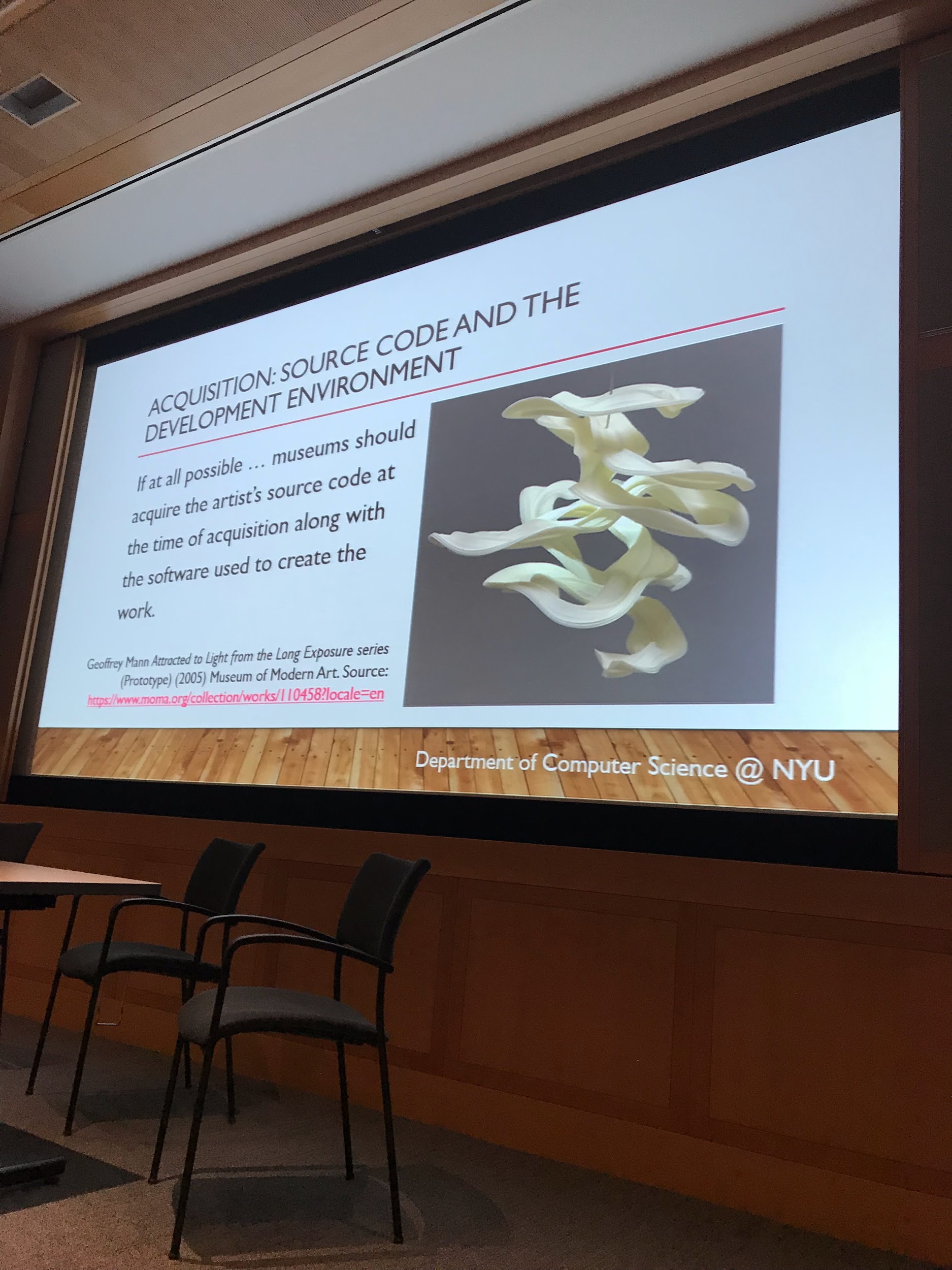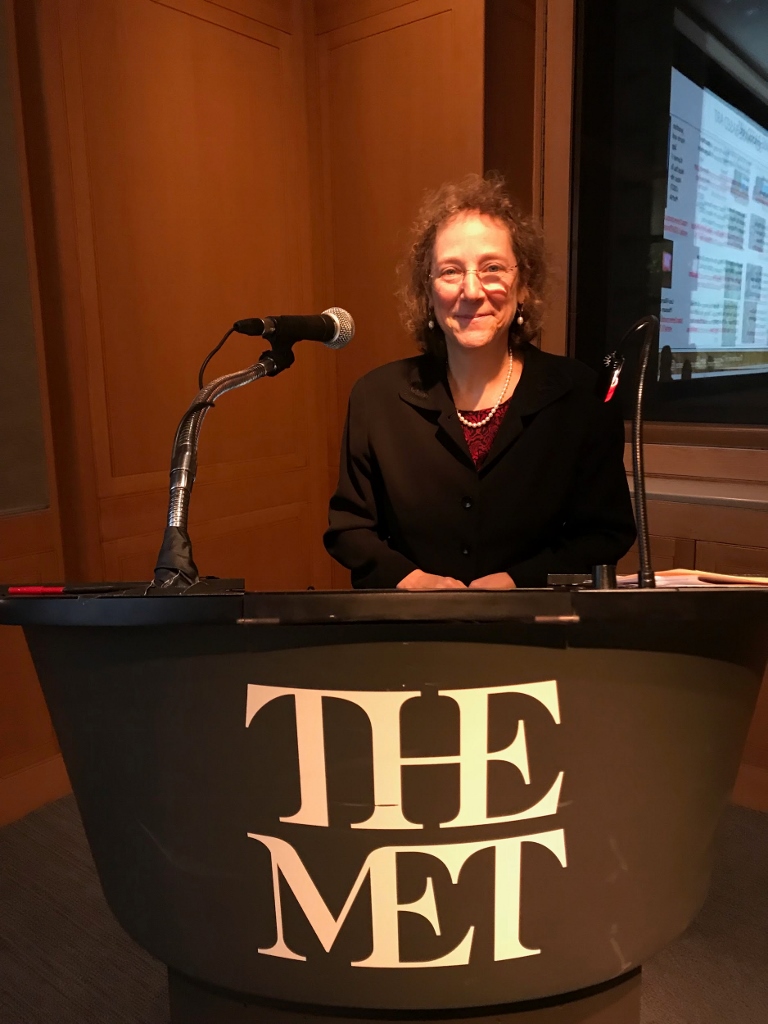This week, we have two contributing authors: Mia Matthias and Michelle Liu.
Mia Matthias is a Curatorial Fellow at the Museum of Modern Art and the Studio Museum in Harlem. A graduate of New York University with a degree in Anthropology and Linguistics, and a minor in Web Programming and Applications, Mia focuses on the intersection of technology and the diaspora and how it is manifested in cultural institutions.
Michelle Liu is a graduate of New York University with double majors in Computer Science and Art History who has participated in the conservation of software and digital based art in conjunction with the Solomon R. Guggenheim Museum of Art. She is currently a consultant at a financial institution working as a functional analyst and software developer.
On November 16, 2017, the Time-Based Media Working Group at the Metropolitan Museum of Art gathered to hear Professor Deena Engel, director of Digital Humanities and Social Sciences at New York University, present “The Life-Cycle of a Software-Based Work of Art: From Creation Through Conservation.” Focusing on software-based art in museum collections, Engel proposed an interdisciplinary framework for the life-cycle of software-based art consisting of four main stages: creation, acquisition, exhibition, and conservation. In positing these stages as interrelated steps within the same process, Engel places the onus of conservation of time-based media upon the artist, the collecting institution, the exhibitors, and the conservators alike. For conservators, understanding key points in each step is vital to maintaining the integrity and longevity of the work of art.
How is the life-cycle of a work of software-based art impacted by the nature of the materials used in its creation? Engel reminds us that at the core of a software-based work of art there exists hardware, code, and scripts that are vulnerable to changing technology. Although there are infinite possibilities of approaches to creation, Engel offers clear examples of high-level programming languages (Java, C, C++, Python), database and query languages (MySQL), applications (IDE: Integrated Development Environment, an application), and more alongside examples from the collections of the Guggenheim Museum, and the Museum of Modern Art. Engel closed the subject of creation with a question that holds reverberations for artists, acquisition committees, and institutions alike: proprietary or open source? An artist’s use of proprietary software, which is under copyright, versus the use of open-source software, which is freely available, can greatly affect how conservators approach the work of art.
The subsequent stage, acquisition, calls the institution to action. Engel underscores one important idea continuously: obtain the source code. Speaking of museums, Engel urges, “If at all possible…museums should acquire the artist’s source-code at the time of acquisition along with the software used to create the work.” Engel presented several cases of existing works in museum collections to the forefront to offer examples of the components that should be taken into consideration in the acquisition of a software-based work of art, including media files (such as images), software libraries (such as sound files), and data sources. In discussing the latter component, Engel suggests that museums always obtain a static copy of the data being culled by the work of art, which can serve both as documentation of the initial content and a point of reference in the event that the data source fails.

Exhibition of artworks always underscores the immense fragility of the objects on display. Engel reminds us that the challenges of exhibiting time-based media are specific to the nature of the artworks, and at times unexpected. Anecdotes of issues encountered in exhibition include updates to Operating Systems and programming languages that render code obsolete, aged hardware failure, and improved processing power resulting in code running more quickly than the artist intended. These variations compromise the original tools and the produce, resulting in a compromised experience. Additionally, interactive works are subject to security concerns, exhibitors must consider the points of vulnerability through which the work could be coopted. This stage is an integral opportunity of learning how the piece functions in practice, which components of the work are susceptible to change, and how to interpret the intention of the artist.
The culmination of the presentation at the stage of conservation functioned less as an endpoint, and more as a reiteration of the principles and practices stressed at each stage of the life-cycle. Engel used the opportunity to further reiterate the importance of thorough documentation during the conservation; by ensuring all components of the artwork are included at the stage of acquisition, conservators are able to refer to records on environment, speed, and experience to re-exhibit the work as it was intended. The process of restoration, when necessary, should involve the opinion and literature of the artist to determine intention and how best to preserve the integrity of their work.
Engel’s cross-sectional perspective on time-based media encourages a top-down approach to conservation. The process begins with the artists’ tools, and progresses into a continuous cooperation and dialogue among artists, collecting and exhibiting institutions, and conservators. Engel urges those involved at each stage to approach the field with an interdisciplinary attitude; a background in conservation and Computer Science is important, along with a willingness to remain abreast of developments in software, archival practices, computational reproducibility, among other fields. The challenges that arise with time-based media are unique and continuously evolving. Developments in processing power, changing software and hardware, and ever-changing data sources all represent risks to the integrity of a work of software-based art. With continuous documentation and a keen understanding of the intention of the artists, time-based media conservators are working to preserve dynamic artworks that will act as a living archive of technology and art for generations to come.

